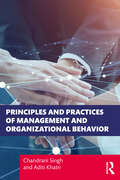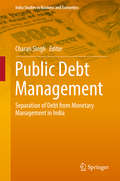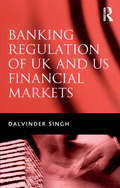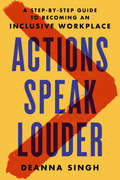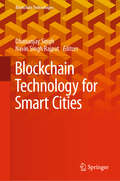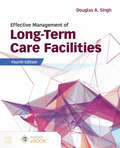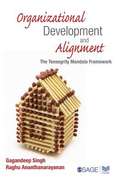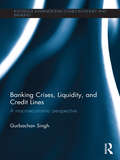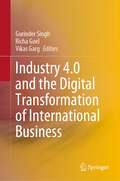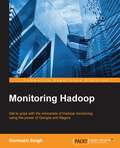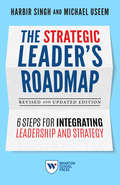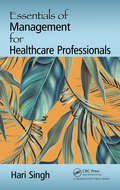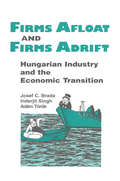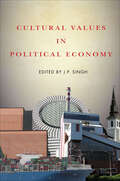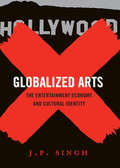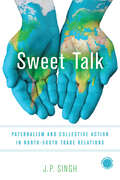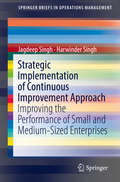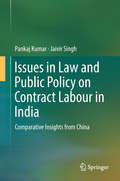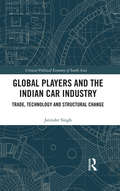- Table View
- List View
Principles and Practices of Management and Organizational Behavior
by Chandrani Singh Aditi KhatriThis book offers perspectives, insights, techniques, and approaches for efficient and contemporary management practices in an organization. It provides a comprehensive insight into the traditional and contemporary approaches of organizational behavior and their impact on organizational performance in the global era. Ranging from planning to staffing, and controlling to strategic decision-making, the case studies in the book incorporate relevant modern management models and correlate practices of management from organizational perspectives to allow any organization’s direction and environment to be evaluated with suggested recommendations. This textbook consists of two broad parts. The first deals with management trends and functions ranging from the traditional era to the contemporary world. The second part explores the behavioral trends of organizations across domains to analyze the measures taken for improved productivity and sustainability.Drawing theories from psychology, sociology and economics, this book probes into the interrelation between behavior and holistic management by examining the impact of teamwork, motivation, organizational power, and polity, instituting relevant organizational ethics and strategies to create healthy organizational culture.This book will be useful to students, academicians, management researchers, and industry professionals from the field of general management and organizational behavior. It will also be useful for scholars interested in management studies, behavioural studies, business and development, developmental studies, sociopsychology, management, and business strategies.
Public Debt Management
by Charan SinghThis book examines the objectives of public debt management and the re-emerging issue of separating monetary policy formulation from fiscal and debt management. The recent Great Recession has resulted in a rethink of the objectives and working of macroeconomics, and in many countries, including India, has led to the scope of fiscal operations being expanded and debt-to-GDP ratios increasing significantly. Consequently, debt management has encountered considerable difficulties, and the need for coordination between monetary and debt management has assumed greater significance. The book discusses the important issue of the independence of central banks and the need for coordination between debt managers, monetary authorities and finance ministries if debt operations are separated from monetary management.
Banking Regulation of UK and US Financial Markets
by Dalvinder SinghDalvinder Singh provides an interdisciplinary analysis of the legal aspects of prudential supervision. This gives the reader a broader understanding of the core processes of banking supervision. By using the UK as a case study, a comparison is made with the US to illustrate the different ways of approaching the issues. The author examines the legal as well as the theoretical, economic, political and policy issues that underpin the purpose of prudential supervision, such as corporate governance, enforcement sanctions, the role of external auditors and accountability of financial regulators. These are considered in the context of broad-policy considerations which render prudential supervision necessary, namely financial stability and depositor protection. The book will be of interest to academics, policymakers, regulators and practitioners, and equally will serve specialist undergraduate and postgraduate programmes in law, management and economics which focus on financial regulation.
Actions Speak Louder: A Step-by-Step Guide to Becoming an Inclusive Workplace
by Deanna Singh"A timely, practical resource on creating teams and organizations where everyone has the opportunity to succeed."--Adam Grant, #1 New York Times bestselling author of Think Again and host of the podcast WorkLife A step-by-step guide for managers, teams, and DEI leaders looking to create impactful, lasting change in their organization, from recruitment to retention, and beyond. Are you tired of hollow promises about diversity, equity, and inclusion in your organization? Do you want to take steps towards real change – beyond issuing mission statements, signing checks, and holding listening sessions – but don&’t know where to start? This book is your answer. Designed for teams to read together, Actions Speak Louder offers a comprehensive blueprint for leaders and teams who are ready to get out of their own way, look at their surroundings with new eyes, and turn their energy into a concrete plan. Renowned DEI consultant Deanna Singh has led diversity trainings for a wide range of organizations, from non-profits to Fortune 500 companies. Using narratives, case studies, and the latest DEI research, as well as interactive exercises, Singh will teach you how to: • Write inclusive job advertisements because &“minorities just don&’t apply here&” isn&’t an excuse – you&’re just not reaching them • Design an interview process that reduces status quo bias and challenges hiring decisions that are simply &“no brainers&” • Create a retention plan that considers and prioritizes the needs of underrepresented employees – if you haven&’t intentionally designed one to be inclusive, you&’ve unintentionally reinforced one that is exclusive. • Lead inclusive meetings – the bedrock of company culture – by practicing constructive dissent and elevating underrepresented perspectives As Singh has seen time and time again, any organization can meaningfully change – you just need the right tools.
Blockchain Technology for Smart Cities (Blockchain Technologies)
by Dhananjay Singh Navin Singh RajputThis book provides a comprehensive overview of various aspects of the development of smart cities from a secure, trusted, and reliable data transmission perspective. It presents theoretical concepts and empirical studies, as well as examples of smart city programs and their capacity to create value for citizens. The contributions offer a panorama of the most important aspects of smart city evolution and implementation within various frameworks, such as healthcare, education, and transportation. Comparing current advanced applications and best practices, the book subsequently explores how smart environments and programs could help improve the quality of life in urban spaces and promote cultural and economic development.
Effective Management of Long-Term Care Facilities
by Douglas A. SinghEffective Management of Long-Term Care Facilities, Fourth Edition examines the complex operations of the long-term care facility and offers critical skills to current and future long-term care administrators for delivering quality, cost-effective services. An excellent resource for both new and seasoned long-term care managers, this logically organized text begins with an understanding of what long-term care is and why it's an integral part of the health care delivery system. It moves on to explore the legal and regulatory parameters and payment constraints within which long-term care facilities must be managed; each of the main functional departments that administrators must understand and oversee; and, effective governance and leadership and management of human resources, marketing and quality—much of which is unique to nursing home administration. The final section of the book offers case studies to simulate situations that the administrator is likely to encounter in practice.
Organizational Development and Alignment: The Tensegrity Mandala Framework
by Gagandeep Singh Raghu AnanthanarayananOrganizational Development and Alignment: The Tensegrity Mandala Framework takes a close look at the underlying axioms of Organization Design and Alignment that have not only proliferated rigid structures and oppressive hierarchies, but also have rendered employees worldwide as mere instruments and dehumanized the organizational context. By looking at an organizational system as inherently a Tensegrity structure, an architectural paradigm vitalized by Buckminster Fuller, the book offers the reader insights into the dynamic tensions, role-holding, and dialog possibilities that pervade the modern organization across stakeholders such as investors, customers, employees and the ecology. By containing the organization as a 'Mandala', a dynamic force field with arrays of polarities and counter-pulls that burden the leadership, it explicates the various dilemmas that are contained within, and offers insights into design, policies, culture and role-effectiveness. The Tensegrity Mandala empowers the organization of today towards reflexivity and transformation. It serves as a blueprint for growth, organization development, dialog, and institutionalizing leadership.
Organizational Development and Alignment
by Gagandeep Singh Raghu AnanthanarayananOrganizational Development and Alignment: The Tensegrity Mandala Framework takes a close look at the underlying axioms of Organization Design and Alignment that have not only proliferated rigid structures and oppressive hierarchies, but also have rendered employees worldwide as mere instruments and dehumanized the organizational context. By looking at an organizational system as inherently a Tensegrity structure, an architectural paradigm vitalized by Buckminster Fuller, the book offers the reader insights into the dynamic tensions, role-holding, and dialog possibilities that pervade the modern organization across stakeholders such as investors, customers, employees and the ecology. By containing the organization as a 'Mandala', a dynamic force field with arrays of polarities and counter-pulls that burden the leadership, it explicates the various dilemmas that are contained within, and offers insights into design, policies, culture and role-effectiveness. The Tensegrity Mandala empowers the organization of today towards reflexivity and transformation. It serves as a blueprint for growth, organization development, dialog, and institutionalizing leadership.
Banking Crises, Liquidity, and Credit Lines: A Macroeconomic Perspective (Routledge International Studies In Money And Banking #70)
by Gurbachan SinghThe banking crises in 2007-10 are not exceptional. There have been many such crises in the past in both developed countries and emerging economies. A banking crisis can be related to solvency or liquidity (or both). This book focuses on banking crisis and liquidity. This book starts from basics and gradually builds up with very few technicalities. Though the analysis is primarily theoretical, we provide a historical background, a macroeconomic perspective, and policy implications for both closed and open economies.
Industry 4.0 and the Digital Transformation of International Business
by Gurinder Singh Richa Goel Vikas GargThe book throws light on the ongoing trends in international business, integration of information technology with global businesses, its role in value co-creation, resource integration, and service for service exchange. While discussing the issues of these areas, chapters of this book also delve into prevalent problematic areas which are closely related like employment, ethical aspects, power creation, and so on. Recognizing the role digitization and new technologies play in enabling global managers to communicate with outside world directly via digital channels irrespective of their location (which is especially true in time of COVID-19), the book takes an emerging economy perspective and throws light on new theories, perceptions, employment opportunities, and innovative ideas through its content. The book not only discusses effects of information technology but also the latest emerging technology in global business like use of artificial intelligence, robotics, machine learning, big data, and their integration with the global business 4.0. Since emergence of these new technologies requires proper infrastructural development, the book also throws light on government initiatives and CSR in this respect. It contains takeaways for both undergraduate and graduate students, researchers and academicians, industry watchers, practitioners, start-ups, and entrepreneurs
Monitoring Hadoop
by Gurmukh SinghThis book is useful for Hadoop administrators who need to learn how to monitor and diagnose their clusters. Also, the book will prove useful for new users of the technology, as the language used is simple and easy to grasp.
Company Governance: Fulfilling Broad Mission and Purpose-What the India Way Can Teach Us about Balancing the Interests of Different Stakeholders
by Harbir Singh Jitendra V. Singh Michael Useem Peter CappelliIn Western companies, the board of directors functions as the owners' eyes and ears, monitoring the performance of company executives and ensuring that they protect shareholder interests. In this chapter, authors Peter Cappelli, Harbir Singh, Jitendra Singh, and Michael Useem show how, in keeping with the India Way, directors of Indian companies balance the interests of all those with a claim on the company-its employees, its customers, the broader community, even the nation-as well as the interests of actual shareholders. Using the example of Infosys Technologies, which has built a governance model that blends both the rules-based approach of Western firms and the values-based approach indigenous to India, the authors make a compelling case for the India Way of corporate governance-and how putting it into practice can help U.S. executives to contribute not just to investor returns, but to their communities; to focus not just on cutting labor costs, but on building their workforces. This chapter was originally published as Chapter 6 of The India Way: How India's Top Business Leaders Are Revolutionizing Management.
Indian Business Rising: The Contemporary Indian Way of Conducting Business-And How It Can Help You Improve Your Business
by Harbir Singh Jitendra V. Singh Michael Useem Peter CappelliIn America, the financial crisis of 2008-2009 shattered public confidence in corporate leaders-a confidence already weakened by huge bonuses, company jets, and golden parachutes. In contrast, Indian business leaders have achieved rock-star status, even as they deliver growth rates that would be the envy of any Western executive. In this chapter, authors Peter Cappelli, Harbir Singh, Jitendra Singh, and Michael Useem introduce "the India Way" of conducting business-characterized by four principal practices: holistic engagement with employees, improvisation and adaptability, creative value propositions, and a broad mission and purpose. The India Way stands in striking contrast to the business practices of other countries, where delivering shareholder value is the primary goal. Using powerful examples such as Tata Motors (developer of the Nano car), Reliance Industries, and Infosys Technologies, the authors present the India Way as a model for Western business leaders who could use it to reinvigorate their own growth rates-and reclaim their reputations in the process. This chapter was originally published as Chapter 1 of The India Way: How India's Top Business Leaders Are Revolutionizing Management.
Managing People: Holistic Engagement of Employees-And How Your Company Can Profit by India's Example
by Harbir Singh Jitendra V. Singh Michael Useem Peter CappelliLeading firms in India-IT services giant HCL Technologies, Reliance Industries, Yes Bank, and Infosys, to name just a few-view managing people as an integral part of their business strategies. The India Way, which stands in striking contrast to the business practices of Western countries, recognizes that strategy is based on internal competencies, and these ultimately come from the actions and efforts of employees. In this chapter, authors Peter Cappelli, Harbir Singh, Jitendra Singh, and Michael Useem examine key aspects of human resource management at Indian firms-recruitment, training and development, employee engagement, and organizational culture-positioning them in stark contrast to their counterparts in U.S. firms. What can Western business leaders learn from the India Way of managing people? A great deal, according to the authors. This chapter was originally published as Chapter 3 of The India Way: How India's Top Business Leaders Are Revolutionizing Management.
The Strategic Leader's Roadmap, Revised and Updated Edition: 6 Steps for Integrating Leadership and Strategy
by Harbir Singh Michael Useem"The Strategic Leader's Roadmap provides an essential playbook for combining business strategy with great leadership."—William P. Lauder, Executive Chairman, The Estée Lauder Companies Inc.In The Strategic Leader's Roadmap, Updated and Revised Edition: 6 Steps for Integrating Leadership and Strategy, Wharton management professors Harbir Singh and Michael Useem offer a six-point checklist for today's leaders to follow. They explain how leading strategically will help managers strengthen their capacity to develop strategy and to lead its execution. Drawing on one-on-one interviews with CEOs, in-depth research, and their experience teaching today's executives and tomorrow's leaders, Singh and Useem take readers into the offices—and mindsets—of some of today's foremost strategic leaders.In this fully updated and revised edition, Singh and Useem explore: How Indra Nooyi rose to become CEO of PepsiCo and led its successful strategic redirection; How Jack Ma consistently pivoted and outflanked competition to position Alibaba to become a global behemoth; How John Chambers, executive chairman of Cisco Systems, changed his and other company leaders' leadership to stay ahead of disruption; How Lawrence Culp Jr., the CEO of Danaher from 2001 to 2014 and later General Electric, increased the market value of Danaher more than four-fold compared to the S&P 500. Fast-reading and actionable, The Strategic Leader's Roadmap will enable leaders at all levels to master the abilities necessary to keep their companies ahead of the competition.
Essentials of Management for Healthcare Professionals
by Hari SinghMedical care is an industry and private providers and hospitals are the major service providers. They operate on business principles. Hospitals are getting highly specialized and complex. The diagnostics and therapeutics are technology intensive. Private establishments have to compete with one another to remain in business. They strive to induct the best talent and latest technical know-how, resulting in ever-increasing costs to patients. Patients, who pay high charges, demand quality as a matter of right. To meet the challenge, hospitals are constrained to bring in professionalism in their systems and services. They appoint qualified professional managers to manage their clinics and hospitals with a view to sparing health professionals to focus on clinical care. Whether right or wrong, ‘management’ is often associated with authority and power. As a result, the medical professionals are reduced to secondary level in some organizations. To retain commanding positions in medical organizations, it has become necessary for the healthcare professionals to learn ‘management’, at least its basics. On the other hand, non-medical managers while managing healthcare services do not get the required cooperation from the medical professionals, as the latter are often secretive and not willing to share medical knowledge. If medical knowledge is demystified, non-medical managers can perform many functions in healthcare organizations proficiently. Both medical and non-medical managers can complement each other in providing quality healthcare services. The book aims to orient clinicians (including physicians and nurses) and other healthcare professionals on the essentials of business management and to familiarize them with management terms and jargon. They can learn to be effective managers besides being health professionals. Similarly, non- medical managers can get familiarized to nuances of clinical care and special managerial requirements of healthcare facilities. They all will be able to relate processes in healthcare settings with the concepts of business management. They can develop expertise on patient relationship management
Firms Afloat and Firms Adrift: Hungarian Industry and Economic Transition
by Inderjit Singh Joseph C. Brada Aadaam TeoreokDesigned for various types of college courses, this book discusses the interpretation of statistical data in such fields as the economy, business, demography, housing, health, education and crime.
Cultural Values in Political Economy
by J. P. SinghThe backlash against globalization and the rise of cultural anxiety has led to considerable re-thinking among social scientists. This book provides multiple theoretical, historical, and methodological orientations to examine these issues. While addressing the rise of populism worldwide, the volume provides explanations that cover periods of both cultural turbulence and stability. Issues addressed include populism and cultural anxiety, class, religion, arts and cultural diversity, global environment norms, international trade, and soft power. The interdisciplinary scholarship from well-known scholars questions the oft-made assumption in political economy that holds culture "constant," which in practice means marginalizing it in the explanation. The volume conceptualizes culture as a repertoire of values and alternatives. Locating human interests in underlying cultural values does not make political economy's strategic or instrumental calculations of interests redundant: the instrumental logic follows a social context and a distribution of cultural values, while locating forms of decision-making that may not be rational.
Globalized Arts: The Entertainment Economy and Cultural Identity
by J. P. SinghOur interactive world can take a creative product, such as a Hollywood film, Bollywood song, or Latin American telenovela, and transform it into a source of cultural anxiety. What does this artwork say about the artist or the world she works in? How will these artworks evolve in the global market? Film, music, television, and the performing arts enter the same networks of exchange as other industries, and the anxiety they produce informs a fascinating area of study for art, culture, and global politics.Focusing on the confrontation between global politics and symbolic creative expression, J. P. Singh shows how, by integrating themselves into international markets, entertainment industries give rise to far-reaching cultural anxieties and politics. With examples from Hollywood, Bollywood, French grand opera, Latin American television, West African music, postcolonial literature, and even the Thai sex trade, Singh cites not only the attempt to address cultural discomfort but also the effort to deny entertainment acts as cultural. He connects creative expression to clashes between national identities, and he details the effect of cultural policies, such as institutional patronage and economic incentives, on the making and incorporation of art into the global market. Ultimately, Singh shows how these issues affect the debates on cultural trade being waged by the World Trade Organization, UNESCO, and the developing world.
Globalized Arts: The Entertainment Economy and Cultural Identity
by J. P. SinghOur interactive world can take a cultural product, such as a Hollywood film, Bollywood song, or Latin American telenovela, and transform it into a source of cultural anxiety. What does this artwork say about the artist or the world she works in? How will these artworks evolve in the global market? Film, music, television, and the performing arts enter the same networks of exchange as other industries, and the anxiety they produce informs a fascinating area of study not only for art and culture but also for global politics. Focusing on the confrontation between global politics and symbolic creative expression, J. P. Singh shows how, by integrating themselves into international markets, entertainment industries give rise to far-reaching cultural anxieties. With examples from Hollywood, Bollywood, French grand opera, Latin American television, West African music, postcolonial literature, and even the Thai sex trade, Singh cites both the attempt to address cultural discomfort and the effort to deny entertainment acts as cultural. He connects creative expression to clashes between national identities, and he details the effect of cultural policies, such as institutional patronage and economic incentives, on the making and incorporation of art into the global market. Ultimately, Singh shows how these issues impact the debates on cultural trade being waged by the World Trade Organization, UNESCO, and the developing world.
Sweet Talk: Paternalism and Collective Action in North-South Trade Relations
by J. P. SinghDeveloped nations strive to create the impression that their hearts and pockets bleed for the developing world. Yet, the global North continues to offer unfavorable trade terms to the global South. Truly fair trade would make reciprocal concessions to developing countries while allowing them to better their own positions. However, five hundred years of colonial racism and post-colonial paternalism have undermined trade negotiations. While urging developing countries to participate in trade, the North offers empty deals to "partners" that it regards as unequal. Using a mixed-methods approach, J. P. Singh exposes the actual position beneath the North's image of benevolence and empathy: either join in the type of trade that developed countries offer, or be cast aside as obstreperous and unwilling. Singh reveals how the global North ultimately bars developing nations from flourishing. His findings chart a path forward, showing that developing nations can garner favorable concessions by drawing on unique strengths and through collective advocacy. Sweet Talk offers a provocative rethinking of how far our international relations have come and how far we still have to go.
Strategic Implementation of Continuous Improvement Approach: Improving the Performance of Small and Medium-Sized Enterprises (SpringerBriefs in Operations Management)
by Jagdeep Singh Harwinder SinghThis book covers the strategic use of continuous improvement (CI) techniques for manufacturing performance improvement. It focuses primarily on strategies that can be adopted by small and middle-sized enterprises in manufacturing in order to meet the global challenges and competition. The book begins with an introduction to CI (or Kaizen), explaining different CI approaches and strategies. Chapter 2 offers a literature review of CI, examining conceptual frameworks, case studies, and surveys. Next, the book deals with the design of the study, detailing the work done in each phase along with the tools, techniques and models. Chapter 4 presents a detailed survey to determine the present status of continuous improvement strategies in the Indian manufacturing industry, to assess the important barriers that effect the implementation of CI strategies, and to also assess the role of key enablers leading to improve the performance of manufacturing operations. Chapter 5 is comprised of detailed case studies to further analyze the application of the discussed CI strategies. The purpose of Chapter 6 is to develop the relationship among the different identified most important barriers in implementing CI approach using interpretive structural modeling (ISM) and classify these barriers depending upon their driving and dependence power. Finally Chapter 7 provides conclusions, addresses potential limitations, and also looks to the future.
Issues in Law and Public Policy on Contract Labour in India: Comparative Insights From China
by Jaivir Singh Pankaj KumarThis book discusses the increasing use of contract labour in India that has accompanied attempts to liberalise the economy. After briefly examining Indian labour laws and public policy, it juxtaposes the country’s labour market practices with international labour standards. The questions that are raised are then explored through a series of empirical studies investigating the use of contract labour in a variety of industries and locations, manifesting a wide-spectrum of concerns including labour standards, productivity and employment relations. The set of comparative research studies within India are supplemented with a field study from the Shenzhen and Guangzhou industrial regions of South China, which are in an advanced stage of industrial development. The unprecedented inflow of capital into China has captivated many developing countries, including India, which has gone on to mimic similar strategies particularly in terms of labour market deregulation. In this context, a set of crucial questions arise – can enforcing ‘labour market flexibility’ in itself provide the required impetus for a nation’s industrial growth? Is the Chinese success in becoming the major destination for foreign direct investments (FDIs) a consequence of a flexible labour regime or is there some other concealed strength to be found in Chinese labour market institutions? In particular it needs to be noted that after double-digit growth for more than 25 consecutive years, China has recognised some of the fallacy of its development path and in 2008 adopted fairly stringent labour laws, which now regulate its labour market. This Chinese trajectory perhaps has lessons for India and other countries that are still struggling on the liberal path. In particular, the Chinese example helps put the Indian field studies in perspective and provides insights into India-specific policy recommendations that could also be useful for the developing world. The book concludes with the observation that where production entails long-term relationships, the interests of both the employer and the workers need to be maintained sustainably. As the title suggests, the book provides takeaways, not only for academics and researchers working in this field but also for lawyers, consultants, politicians, bureaucrats, and policymakers.
Global Players and the Indian Car Industry: Trade, Technology and Structural Change (Critical Political Economy of South Asia)
by Jatinder SinghThis book is one of the first critical analyses of the automobile industry in India. It studies the sector in general and the passenger car industry in particular, and provides valuable insights into the operation of Foreign Direct Investment (FDI) companies in a technology-intensive industry under changing economic regimes. The volume underlines the influence of the changing nature of foreign investment, the impact of economic reforms, technology regimes and industrial policy on growth, structural changes and development. It offers a detailed account of the trade performance of manufacturers in India’s passenger car industry. It also looks at successful cases to draw policy lessons towards encouraging quality FDI and developing India as a base for world production. A useful addition to industry studies in India, this book with its wide coverage and contemporary analyses will interest scholars and researchers of economics, Indian economy and industrial policy, industrial economics, automobile industry and manufacturing sector, development economics and international economics. It will also appeal to policymakers, practitioners and industrial associations.
Brands and Consumers: A Research Overview (State of the Art in Business Research)
by Jaywant Singh Benedetta CrisafulliBrand management is firmly established as a core business and marketing activity. The research evidence on how consumers react to branding, however, is in constant evolution globally. This short-form book provides a comprehensive overview of research evidence on several core branding topics whilst acting as a catalyst for advancing future research and informing business practice. The book fills a gap created by prior volumes on branding that, although well- illustrated and explained, have often approached the subject in somewhat uncritical manner. The book represents a timely compendium on popular topics in branding and aims to be a valuable addition to knowledge in branding. The book focuses on reviewing research in branding and brand management, and proposes areas for expanding research in the field. Recognising the diversity of research in branding, the authors of this book, as active branding researchers, attempt to discuss the limitations of current research and provide insights for future explorations. The book will be of interest and a resource for academic researchers, branding practitioners, business students and policymakers who view branding as an evidence-oriented discipline.
